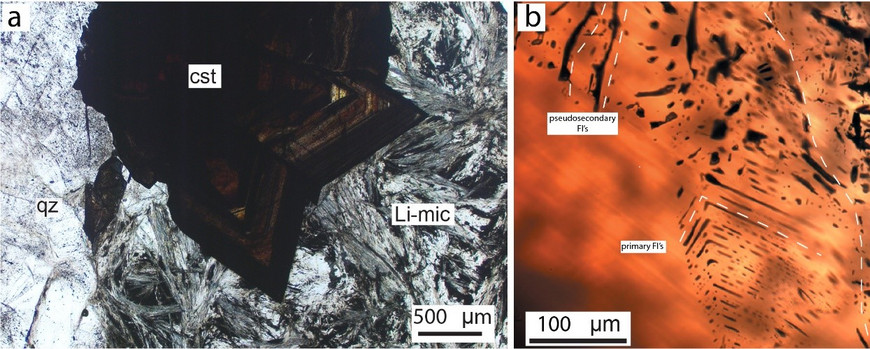The fate of light and mobile elements in magmatic-hydrothermal greisen systems – a combined study of minerals, fluids and gases
Greisen deposits are valuable sources of tin and tungsten. Moreover, the increase in the demand of battery raw materials has led to a recent resurge in their economic and strategic interest as they may host significant lithium resources. Such Li-Sn-W greisen systems are widespread across Central and Western Europe; they are intimately associated with granitic intrusions that form part of the Paleozoic Variscan Orogenic Belt. As tin and tungsten were previously the main commodities of interest, the geochemistry and distribution of lithium and other light and lithophile elements, particularly during the hydrothermal stages of greisen systems, remains insufficiently understood. It is the focus of the present study to provide insight of the fate of such light and mobile elements in greisen systems.
A suitable case study, the Sadisdorf Sn-W-Li prospect in eastern Germany (Fig. 1a and b) was selected. At Sadisdorf magmatic-hydrothermal mineralization is related to a highly fractionated granitoid intrusive stock that was emplaced during the late stage of the Variscan Orogeny. The mineralization occurs as granite-hosted metasomatic greisen (endogreisen) and as vein- as well as breccia-style mineralization hosted by paragneisses and older intrusions (exogreisen). Good exposure at surface as well as underground, and numerous historic drill-cores that cover proximal as well as distal positions of the magmatic-hydrothermal system, provide an ideal situation to study the spatial and temporal evolution of a greisen deposit. Our analytical approach includes major and trace element as well as stable isotope analyses (EMPA, LA-ICP-MS) of greisen minerals (Fig. 2a; quartz, topaz, mica, apatite and fluorite) and fluid inclusion analyses in ore (Fig. 2b; cassiterite and wolframite) as well as gangue minerals (microthermometry and LA-ICP-MS). Fluid inclusion studies will be complemented by analyses Raman-spectroscopy and fast scanning crush-leach analyses specifically aiming to characterize the related gaseous components in the mineralizing system. Through this approach, we aim to improve the understanding of the geological processes that cause efficient enrichment of light and mobile elements as well as Sn and W in complex greisen systems.
References:
Hoth, K., Tischendorf, G., Berger, H.J., Wasternack, J., Breiter, K., Mlcoch, B., Schovanek, P., Eilers, H., Fritzsche, H., and Hanig, C. (1980): Geologische Karte Erzgebirge/Vogtland: Dresden, Sächsisches Landesamt für Umwelt und Geologie, Bereich Boden und geologie, scale 1: 100,000, 2 sheets.
Romer, R. (2012): Geochronology of the Erzgebirge: a messy can of worms. In: Romer, R.L., Förster, H.-J., Kroner, U., Müller, A., Rößler, R., Rötzler, J., Seltmann, R., and Wenzel, T. (eds.) Granites of the Erzgebirge - relation of magmatism to the metamorphic and tectonic evolution of the Variscan Orogen. Scientific Technical Report 12/15, GFZ German Research Centre for Geosciences
Seltmann, R. (1984): Erzformationelle und tektonische Analyse der Bildungen der Quarz-Kassiterit-Formation im Revier Schmiedeberg-Niederpöbel-Sadisdorf. – Diplomarbeit, TU Bergakademie Freiberg, 158 S.; Freiberg.


